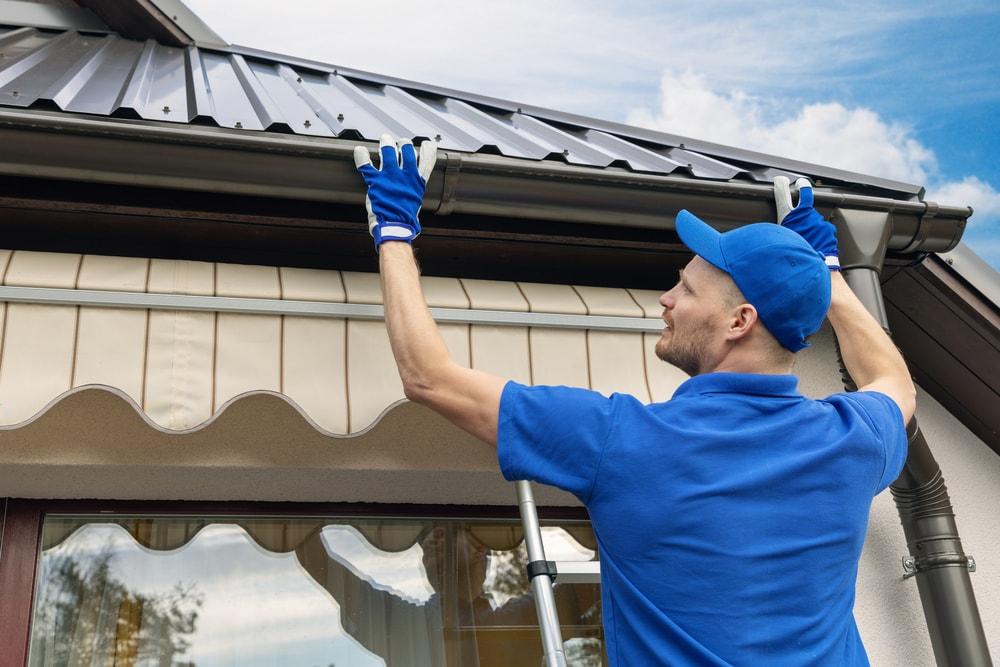Gutters play a crucial role in the drainage system of any home. Like other exterior elements, they endure constant exposure to the elements of the outdoors. During the spring, routine gutter maintenance, such as inspecting and cleaning the gutters, is essential to keep your home’s gutters in good shape. Maintaining your gutters will significantly extend their service life.

Sadly, a time will come when you need to replace your gutters. If you notice signs of severe wear, such as holes, cracks, or leaks, or if your roof is pulling away from your house, it’s time to replace it. Working with a professional is the best way to ensure the proper installation of new gutters. Remember the risks of improper gutter installation, especially if you decide to handle the task yourself.
If you’re planning to replace your gutters soon or hire a professional, there are a few key factors to consider. They are:
- Gutter System Type
There are two types of gutter systems on the market: sectional and seamless. Today, most homeowners will opt for the seamless system since they have fewer connection points.
Most of the gutter options are available in 10-foot sections that link together with snap-in connectors. The joints in sectional systems eventually degrade and leak, which is a drawback.
Seamless systems feature seams only at the corner points and are typically available in metal.
- Maintenance Or Upkeep Requirement
Like any part of your home, the type of gutter system you’ll choose will require routine care and maintenance to keep it functional throughout the year. Gutters require routine inspection and cleaning, especially if you have trees on your property.
If you lack time to perform routine maintenance on your gutters, a seamless system may be a good option to ensure functionality and aesthetics without too much maintenance. If you want to ensure the right one for your home, you might want to check out reliable options such as the K-Guard Leaf-Free Gutter System or others as a good start.
The sectional gutters will require routine maintenance to ensure they stay functional. When you have this gutter system, they tend to misalign and result in water damage to your roof and foundation. Depending on the material of the sectional gutter you’ll choose, be ready for a replacement, especially once you find signs of wear over time.
- Type Of Material
The type of material is a significant factor when choosing gutters because it affects the quality.
Stainless steel or copper gutters are often more expensive, but they’re more durable and can withstand adverse weather for a longer period.
Other materials, such as polyvinyl (PVC) or aluminum gutters, are less expensive but will not last as long.
Here are the different types of gutter materials to keep in mind:
- Aluminum is the most popular because it’s lightweight, corrosion-resistant, and comes in various colors at a reasonable price.
- Galvanized steel gutters have a zinc coating and are quite strong, but they’re susceptible to rust in the long run.
- Steel gutters with zinc or aluminum coating eliminate the corrosion problem yet come at a higher cost.
- Zinc gutters are durable and strong; plus, they don’t need to be finished or painted.
- Copper gutters are one of the more durable options, but they’re also more expensive than other metals.
- Vinyl gutters are available in various colors and are an affordable option. The tendency for this type of material to deteriorate over time due to exposure to the elements is a disadvantage.
- Gutter Design
Aside from the material, the shape or profile of the gutter is also a consideration during the selection process, which should work well with your current roof design.
- The most popular design, which resembles decorative crown molding, is the K-style or ogee gutter.
- Half-round gutters boast an open construction in which the open side faces the roof. The design has the disadvantage of being prone to obstruction and overflow.
- Fascia gutters showcase a smooth facade that works in the same manner as fascia boards, concealing the fringes of the rafter tails.
- Roof Pitch
The roof pitch is also a consideration when selecting new gutters for your home. Keep in mind that this is an important consideration because it’ll determine the width of the gutters and downspouts.
The slope of the gutters will also determine the overall effectiveness of your downspouts. Steep slopes are more likely to work better because they create a better flow of water that can readily wash away any debris buildup.
Nonetheless, if the pitch is too steep, it can harm the curb appearance of your property and potentially harm the fascia boards in the long run.
- Rainfall Rate
If you work with a reliable gutter company, they know the local rainfall rates and the right gutter for your home. While you’re talking to the professional about the rainfall rates, ask if they also do gutter protection installation. If your budget allows, investing in protection such as gutter guards or covers is a good choice.
Final Thoughts
The gutter system in your home plays an important role in maintaining the overall structural integrity. Years of constant exposure to the weather can cause the gutters to deteriorate. If you’re looking to replace your home’s worn-out gutters, these helpful hints will help you find the right one in no time.





